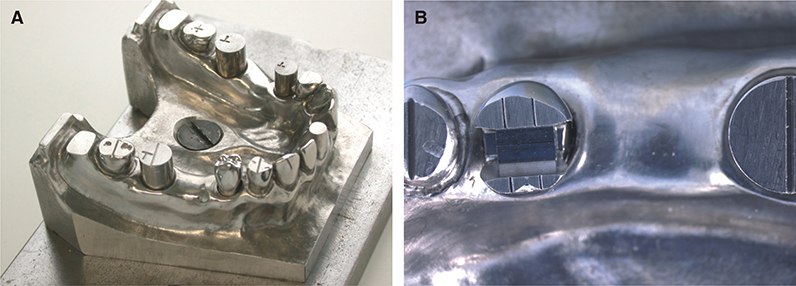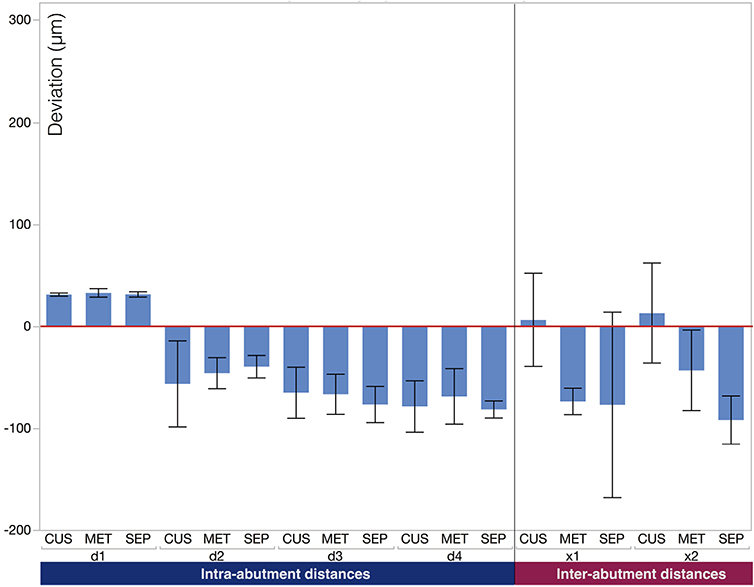J Adv Prosthodont.
2017 Aug;9(4):287-293. 10.4047/jap.2017.9.4.287.
Accuracy of a separating foil impression using a novel polyolefin foil compared to a custom tray and a stock tray technique
- Affiliations
-
- 1Department of Periodontology, Endodontology and Cariology, University Center of Dental Medicine, University of Basel, Basel, Switerland. n.zitzmann@unibas.ch
- 2Department of Conservative Dentistry and Periodontology, University of Würzburg, Würzburg, Germany.
- KMID: 2398076
- DOI: http://doi.org/10.4047/jap.2017.9.4.287
Abstract
- PURPOSE
To compare the dimensional accuracy of three impression techniques- a separating foil impression, a custom tray impression, and a stock tray impression.
MATERIALS AND METHODS
A machined mandibular complete-arch metal model with special modifications served as a master cast. Three different impression techniques (n = 6 in each group) were performed with addition-cured silicon materials: i) putty-wash technique with a prefabricated metal tray (MET) using putty and regular body, ii) single-phase impression with custom tray (CUS) using regular body material, and iii) two-stage technique with stock metal tray (SEP) using putty with a separating foil and regular body material. All impressions were poured with epoxy resin. Six different distances (four intra-abutment and two inter-abutment distances) were gauged on the metal master model and on the casts with a microscope in combination with calibrated measuring software. The differences of the evaluated distances between the reference and the three test groups were calculated and expressed as mean (± SD). Additionally, the 95% confidence intervals were calculated and significant differences between the experimental groups were assumed when confidence intervals did not overlap.
RESULTS
Dimensional changes compared to reference values varied between -74.01 and 32.57 µm (MET), -78.86 and 30.84 (CUS), and between -92.20 and 30.98 (SEP). For the intra-abutment distances, no significant differences among the experimental groups were detected. CUS showed a significantly higher dimensional accuracy for the inter-abutment distances with -0.02 and -0.08 percentage deviation compared to MET and SEP.
CONCLUSION
The separation foil technique is a simple alternative to the custom tray technique for single tooth restorations, while limitations may exist for extended restorations with multiple abutment teeth.
Keyword
MeSH Terms
Figure
Reference
-
1. Zimmermann M, Mehl A, Mörmann WH, Reich S. Intraoral scanning systems - a current overview. Int J Comput Dent. 2015; 18:101–129.2. Yuzbasioglu E, Kurt H, Turunc R, Bilir H. Comparison of digital and conventional impression techniques: evaluation of patients' perception, treatment comfort, effectiveness and clinical outcomes. BMC Oral Health. 2014; 14:10.3. Joda T, Lenherr P, Dedem P, Kovaltschuk I, Bragger U, Zitzmann NU. Time efficiency, difficulty, and operator's preference comparing digital and conventional implant impressions: a randomized controlled trial. Clin Oral Implants Res. 2016; 09. 05.4. Chochlidakis KM, Papaspyridakos P, Geminiani A, Chen CJ, Feng IJ, Ercoli C. Digital versus conventional impressions for fixed prosthodontics: A systematic review and meta-analysis. J Prosthet Dent. 2016; 116:184–190.5. Ender A, Attin T, Mehl A. In vivo precision of conventional and digital methods of obtaining complete-arch dental impressions. J Prosthet Dent. 2016; 115:313–320.6. Güth JF, Runkel C, Beuer F, Stimmelmayr M, Edelhoff D, Keul C. Accuracy of five intraoral scanners compared to indirect digitalization. Clin Oral Investig. 2016; 07. 12.7. Boeddinghaus M, Breloer ES, Rehmann P, Wöstmann B. Accuracy of single-tooth restorations based on intraoral digital and conventional impressions in patients. Clin Oral Investig. 2015; 19:2027–2034.8. Hamalian TA, Nasr E, Chidiac JJ. Impression materials in fixed prosthodontics: influence of choice on clinical procedure. J Prosthodont. 2011; 20:153–160.9. Wadhwani CP, Johnson GH, Lepe X, Raigrodski AJ. Accuracy of newly formulated fast-setting elastomeric impression materials. J Prosthet Dent. 2005; 93:530–539.10. Eames WB, Sieweke JC, Wallace SW, Rogers LB. Elastomeric impression materials: effect of bulk on accuracy. J Prosthet Dent. 1979; 41:304–307.11. Mansfield MA, Wilson HJ. Elastomeric impression materials. A method of measuring dimensional stability. Br Dent J. 1975; 139:267–272.12. Schnell R, Phillips RW. Dimensional stability of rubber base impressions and certain other factors affecting accuracy. J Am Dent Assoc. 1958; 57:39–48.13. Boulton JL, Gage JP, Vincent PF, Basford KE. A laboratory study of dimensional changes for three elastomeric impression materials using custom and stock trays. Aust Dent J. 1996; 41:398–404.14. Van Noort R. Impression Materials. In : Van Noort R, editor. Introduction to dental materials. London: Mosny Elsevier;2007. p. 186–208.15. Shillingburg HT Jr, Hatch RA, Keenan MP, Hemphill MW. Impression materials and techniques used for cast restorations in eight states. J Am Dent Assoc. 1980; 100:696–699.16. Clark DM, Oyen OJ, Feil P. The use of specific dental school-taught restorative techniques by practicing clinicians. J Dent Educ. 2001; 65:760–765.17. Chee WW, Donovan TE. Polyvinyl siloxane impression materials: a review of properties and techniques. J Prosthet Dent. 1992; 68:728–732.18. Chugh A, Arora A, Singh VP. Accuracy of different putty-wash impression techniques with various spacer thickness. Int J Clin Pediatr Dent. 2012; 5:33–38.19. Nissan J, Laufer BZ, Brosh T, Assif D. Accuracy of three polyvinyl siloxane putty-wash impression techniques. J Prosthet Dent. 2000; 83:161–165.20. Shiozawa M, Takahashi H, Finger WJ, Iwasaki N. Effects of the space for wash materials on sulcus depth reproduction with addition-curing silicone using two-step putty-wash technique. Dent Mater J. 2013; 32:150–155.21. Manoj SS, Cherian KP, Chitre V, Aras M. A comparative evaluation of the linear dimensional accuracy of four impression techniques using polyether impression material. J Indian Prosthodont Soc. 2013; 13:428–438.22. Terry DA, Tric O, Blatz M, Burgess JO. The custom impression tray: fabrication and utilization. Dent Today. 2010; 29:132134–135.23. Singh K, Sahoo S, Prasad KD, Goel M, Singh A. Effect of different impression techniques on the dimensional accuracy of impressions using various elastomeric impression materials: an in vitro study. J Contemp Dent Pract. 2012; 13:98–106.24. Saunders WP, Sharkey SW, Smith GM, Taylor WG. Effect of impression tray design and impression technique upon the accuracy of stone casts produced from a putty-wash polyvinyl siloxane impression material. J Dent. 1991; 19:283–289.25. Nissan J, Rosner O, Bukhari MA, Ghelfan O, Pilo R. Effect of various putty-wash impression techniques on marginal fit of cast crowns. Int J Periodontics Restorative Dent. 2013; 33:e37–e42.26. Dugal R, Railkar B, Musani S. Comparative evaluation of dimensional accuracy of different polyvinyl siloxane putty-wash impression techniques-in vitro study. J Int Oral Health. 2013; 5:85–94.27. Kumar V, Aeran H. Evaluation of effect of tray space on the accuracy of condensation silicone, addition silicone and polyether impression materials: an in vitro study. J Indian Prosthodont Soc. 2012; 12:154–160.28. Nissan J, Gross M, Shifman A, Assif D. Effect of wash bulk on the accuracy of polyvinyl siloxane putty-wash impressions. J Oral Rehabil. 2002; 29:357–361.29. Rathee S, Eswaran B, Eswaran M, Prabhu R, Geetha K, Krishna G, Jagadeshwari . A comparison of dimensional accuracy of addition silicone of different consistencies with two different spacer designs - In-vitro study. J Clin Diagn Res. 2014; 8:ZC38–ZC41.30. Stober T, Johnson GH, Schmitter M. Accuracy of the newly formulated vinyl siloxanether elastomeric impression material. J Prosthet Dent. 2010; 103:228–239.31. Donovan TE, Chee WW. A review of contemporary impression materials and techniques. Dent Clin North Am. 2004; 48:vi–vii. 445–470.32. Luthardt RG, Walter MH, Weber A, Koch R, Rudolph H. Clinical parameters influencing the accuracy of 1- and 2-stage impressions: a randomized controlled trial. Int J Prosthodont. 2008; 21:322–327.33. Bomberg TJ, Hatch RA, Hoffman W Jr. Impression material thickness in stock and custom trays. J Prosthet Dent. 1985; 54:170–172.34. Syrek A, Reich G, Ranftl D, Klein C, Cerny B, Brodesser J. Clinical evaluation of all-ceramic crowns fabricated from intraoral digital impressions based on the principle of active wavefront sampling. J Dent. 2010; 38:553–559.
- Full Text Links
- Actions
-
Cited
- CITED
-
- Close
- Share
- Similar articles
-
- A comparative study on the accuracy of impression body according to the types of impression tray
- A comparative study of impression methods using stock tray and intraoral scanner in a completely edentulous
- A STUDY ON ACCUARACY AND DIMENSIONAL STABILITY ACCORDING TO IMPRESSION METHODS
- Accuracy of stone cast produced by adjustable dental impression tray
- Comparative accuracy of new implant impression technique using abutments as impression copings with an angulated implant model




